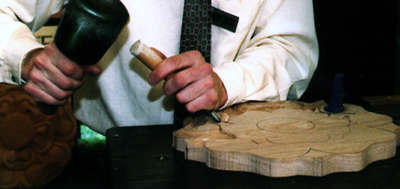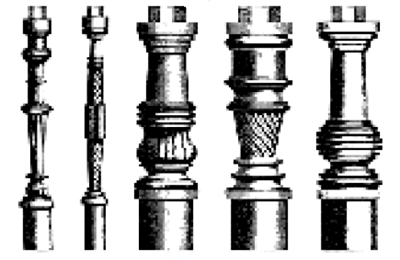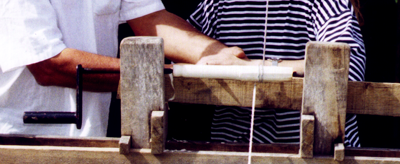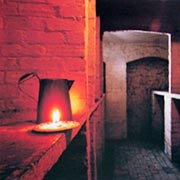Wood carving and turning
Wood has traditionally been categorised as softwood from coniferous trees, or hardwood from deciduous trees that shed their leaves during the winter. Coniferous softwoods were principally used for most general carpentry work, with hardwoods being reserved for high quality fittings, such as doors to formal rooms and wall panelling. The Regency architect and carpenter then further grouped timber into timber from America, timber from Europe and domestic homegrown timber.
Softwoods, such as red, yellow, and white firs, were imported from Norway, Russia, Sweden and North America, and were widely used for the rough framing out of the walls, floor and roofs of houses. Although American white pine was also promoted as being the best for making base mouldings for internal ornamentation.

Above: young boy trying wood turning
Hardwoods, such as sycamore, lime, poplar and oak, were abundantly grown in the Wealden basin between the North and South Downs. These were occasionally used for floor boards and internal panelling. Oak, which was employed abundantly for structural purposes, was sometimes obtained from Holland and Germany, as this was easier to work with and less expensive. The very best joinery and furniture was made from exotic timbers, typically imported from Honduras and Jamaica.
The floors and roofs of Regency houses are primarily made of timber, as are many of the internal fittings. Much of the wood used in the building of Regency Brighton and Hove was imported from the Baltic and shipped into the port of Shoreham. This timber would have arrived in a partially worked condition as ‘planks’, generally about 11/4 by 9, and ‘deals’ of roughly 10 by 3 pieces. About twenty three types of wood were used in the construction of the Regency house, with fashion and economy determining which was in favour.
Wood carving
Wood carving is the practice of cutting away portions of wood to produce a decorative result. Very many different tools are used by the master wood carver. The basic types are: the mallet, which is used to drive the cutting tools and is traditionally cylindrical and made of a heavy, dense wood; chisels, whose straight cutting edges are used for carving lines and cleaning up flat surfaces; gouges, whose curved cutting edges are used for carving hollows, rounds and sweeping curves; and rasps and files, which are used to abrade the surface of the wood.

In the nineteenth century, wood carvers were decorating the wooden cornices, newels and overdoors of houses, embellishing furniture and artefacts, and were also employed in less obvious ways, such as in the carving of patterns on to the fruit wood blocks used in the printing of wallpapers. It produced much of the decoration employed to the inside of the Regency home, and some used on the outside, where it could give the illusion of complex stonework. Capitals, festoons, pilasters and modillions were often carved in wood and finished with a patent render, although during the Regency, period stucco mouldings gradually replaced carved timber examples.
Lime wood was a favourite with the English decorative wood carver as it was close-grained, hard, and could be easily carved or ‘dominated’ in any direction. Oak is also a very good carving wood, as it is durable and tough without being too hard. When producing an intricate design the carver was careful to ensure that the more delicate parts ran with, rather than across the grain, and fine details should not be separated too much from their surroundings. These are the two primary rules of wood carving, and failure to observe them often means that the finished work is susceptible to damage and deterioration.

Above: Carved wooden balusters.
The woodcarver would first line out his work with chalk and fine chisels before using the many different specialised tools required to manipulate grain direction and density appropriately. Amongst these were a heavy cylindrical wooden mallet for 'steering', various flat and curved carving tools, and sets of coarse and fine rasps and files.
Wood turning
Wood turning was a country and town craft carried out on various lathe types. One of the most common being the ‘pole lathe’ used by the bodger, from who’s name we derive the term ‘to bodge it’. The pole lathe consists of a bed or table, fixed to which are two stout vertical posts called ‘puppets' or ‘poppets'. The wood to be turned, which was usually of green, unseasoned stock, would be gripped between an iron pin on one post and an adjustable screw on the other. The pole lathe is turned by means of a foot treadle. A cord is fixed to the treadle, passes several times round the wood to be turned, and is fixed to the end of a springy pole suspended above the table. When the treadle is pressed to the ground, the wood rotates forwards, and the turner works it with his tools, a wide range of gouges and chisels each cutting to a different profile and width.

The turner might produce roughs of profiles which would be finished by others or complete pieces of work on the lathe where the wood is first roughly rounded using a gouge, then chiselled to give the piece the dimensions and shape required. Finally, the wood is sanded, waxed and polished while still revolving. Amongst the finished products the turner would made were rungs, legs, stair balusters, candlesticks, coat hooks and the handles for a variety of tools used by different types of craftsmen.
If you are interested in further reading on this topic, these links will provide you with more information:
White Eagel Studios' wood carving - a bit of history
The Woodcarvings Cabin; History of woodcarving
British Woodturners Assosiation; Brief history of woodturning
Woodturning history by the Woodturning Gallery



